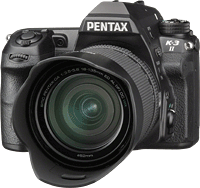Ricoh’s flagship Pentax K-3 II APS-C DSLR is better for sports, in the studio, and once the sun sets
posted Wednesday, April 22, 2015 at 5:00 PM EST

It's no secret that the Pentax K-3 is one of our favorite APS-C DSLRs in the last couple of years. Now, brand owner Ricoh follows up with the Pentax K-3 II, a DSLR that takes the best of its previous enthusiast-grade flagship, and makes some very important changes that will benefit sports, studio, available-light and astrophotographers, as well as those who just want their photos geotagged.
The heart and soul of the Pentax K-3 is still here. The Pentax K-3 II sports the exact same weather-sealed magnesium-alloy body with its excellent ergonomics, and both the 24.35-megapixel APS-C CMOS image sensor and PRIME III image processor are also retained for the K-3's mid-term update. The K-3 II still shoots at a swift 8.3 frames per second to manufacturer ratings, and boasts a wide sensitivity range of ISO 100 to 51,200 equivalents.
The most obvious change is the removal of the popup flash strobe that previously sat on top of the viewfinder prism, now replaced by the circuitry that in the past made up the external O-GPS1 GPS Unit accessory. With the GPS receiver and electronic compass now in-camera along with the requisite orientation sensors, the Pentax K-3 II can now not only geotag photos and adjust its time automatically based on satellite data, but also freeze star trails using Ricoh's unique ASTROTRACER function, all without any external accessories.

The Pentax K-3 II is also the first camera to include Ricoh's clever multi-shot Pixel Shift Resolution System which we discussed recently, and which bears a strong resemblance to -- but some important differences from -- Olympus' High Resolution mode in the E-M5 II, as you'll find out in our Pentax K-3 II preview. With four shots combined, the K-3 II can provide full-res 24-megapixel images with full color at every pixel location and a finer-grained noise structure that's easier on the eye (and likely easier to control in post-processing, too).
Nor is that all: Ricoh has also improved the Pentax K-3 II's in-camera image stabilization system to a CIPA-rated 4.5 stops, up from 3.5 stops in the K-3, and added a function to detect panning, and stabilize on axes other than that which you're panning along. And as if that wasn't enough to show that the company wants to court sports shooters with its new flagship, Ricoh has also improved the K-3 II's continuous autofocus tracking capabilities.
Of course, it bears repeating that there's no longer an internal flash strobe in the Pentax K-3 II. For some, that will be seen as a benefit, as pros tend to look on these as a consumer-grade feature that's a potential point of failure. For others, it will be seen as a disadvantage because it means you'll need to bring along an external strobe if there's even a remote possibility that available light won't prove sufficient for a shoot. And if you like shooting with wireless flash, you'll need one more strobe than before, so that the camera body can communicate with the remote strobes in the absence of a built-in flash.

Available from May 2015, the Pentax K-3 II will be priced at US$1,100 in the US market, a handy 15% below list-pricing for the original K-3 at launch. Given its enthusiast-oriented feature set, and the fact that many prospective owners will already have a selection of Pentax K-mount glass, the K-3 II will only be sold body-only in this market.
In other respects, the Pentax K-3 II is very similar to the existing K-3, sharing basically the same imaging pipeline and most of the same feature-set. You'll find a whole lot more information in our Pentax K-3 II preview, and if this camera tickles your fancy we'd suggest also reading over our existing, in-depth Pentax K-3 review.